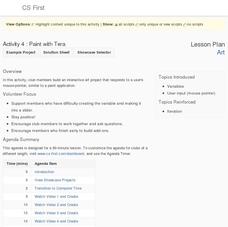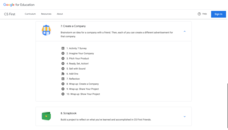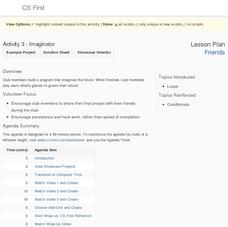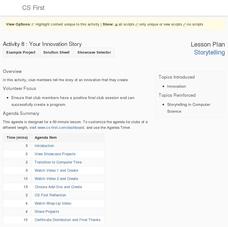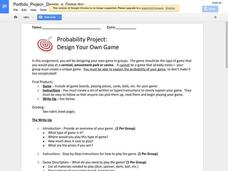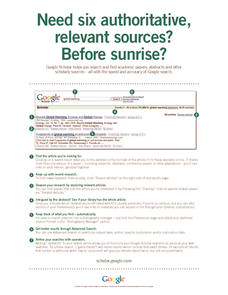Google
Art: Paint with Tera
Here's a creative resource that definitely isn't paint by numbers. As the fourth in and eight-part Art series, learners create a paint program using the Scratch block code. By completing the activity, class members come to understand the...
Google
Art: Interactive Art
What would the Mona Lisa say if she could talk? Scholars create a digital story within the Scratch block-based coding program. They make famous paintings talk and move when viewers click on them to complete the third of eight parts in...
Google
Art: Introduction and Discovery
Art isn't the first thing that comes to mind when thinking about computer science. The first installment of an eight-part Google CS Art unit introduces the series and highlights class procedures. Pupils view videos that show how to use...
Google
Friends: Create a Company
Create a company, advertise it, and hope it grows. The seventh of eight parts in the Google CS First Friends unit challenges future business leaders to apply computer coding to create an advertisement for a company. After pairs come...
Google
Friends: Texting Story
Sometimes it's okay to text in school. Young computer scientists work in the Scratch program to write a text message conversation among friends. They use different sprites within the program to represent each side of the conversation to...
Google
Friends: Imaginator
What does a future as a computer scientist look like? Pupils learn about loops in computer coding by writing a story about the future. They include the repeat until and wait blocks in the Scratch program to incorporate these loops.
Google
Storytelling: Your Innovation Story
Explore a trailblazing way to talk about innovation. Using the Scratch coding program, young computer scientists create innovations and write stories to accompany them. They include some of the add-ons they mastered throughout the unit.
Google
Online Safety Roadshow Activity
What does it mean to have digital citizenship? A set of lessons teach middle schoolers how to be safe and productive online. From sharing posts to creating secure passwords, learners discuss the importance of remaining diligent—and...
Google
Writing Topic Sentences
An engaging and quick presentation on writing topic sentences is sure to grab the attention of your elementary writers. The PowerPoint can be modified and includes relevant visual examples.
Google
Probability Project: Design Your Own Game
Designing a game is the focus of this probability lesson. Groups develop and build a unique game, including directions for how to play, a calculation of the expected value of winning, and a personal reflection. The plan provides a...
Google
Erosion?
What's the difference between wind erosion and water erosion? Perform an experiment to study the effects of air on soil, as well as water and soil, and how effective it can be to place rocks on the soil.
Google
Foldable Inequalities
Your learners will enjoy this simple summary of finding and graphing the solutions to variable inequalities.
Google
Quadratic Formula Foldable
Learners use the determinant of the quadratic formula to find the number of real number solutions that exist in each given quadratic function.
Google
Solving Systems of Equations Foldable
Two of the strategies for solving systems of linear equations are represented in this foldable: substitution and elimination. Learners solve three examples of each.
Google
Pythagorean Theorem Foldable
Your geometry learners will enjoy this color-coded foldable that simply asks them to find the lengths of different legs and the hypotenuse of a right triangle using the Pythagorean Theorem.
Google
History of Math Lesson Plan
Learners honor mathematicians who have contributed important discoveries throughout history by researching and creating a report about a famous mathematician and their contributions to the history of mathematics. Pairs of learners...
Google
Biochemical Structures
It's truly amazing how life is sustained through the complicated interactions of different organic compounds. As young biochemists complete this worksheet, they demonstrate their ability to identify these essential molecules as well as...
Google
Properties of + and x Foldable
Clarify for young scholars the basic properties of addition and multiplication with this foldable math resource. Written on the front flaps are the terms commutative, associative, identity, and inverse...
Google
Sub Report
Receive clear feedback from substitute teachers with this easy-to-use template. With room for up to six class periods, substitutes are asked to grade and comment on each period, while also writing a general account of...
Google
Better Searches. Better Results.
Show your researchers how to get better results when using a search engine to find information with a template that models 10 search strategies. The suggestions explain what to type, what the search engines does, and what results users...
Google
Anatomy of a Search
How does Google work? That is the question answered by this printable. The four steps (search, analyze, evaluate, and rank) are detailed. A great way to launch a discussion of the strengths and weaknesses of this research tool.
Google
Need Six Authoritative, Relevant Sources? Before Sunrise?
Is your class beginning a project? Here's a template that shows researchers how to use the features of Google Scholar. Directions for how to use Advanced Search, Operators, and Bibliography Manager, as well as how to locate affiliated...
Google
Student Information and Transportation
Use a straightforward form to keep track of your class's information. It includes spaces for emergency contact information, allergies, birthday, and transportation requirements.
Google
Design and Budget Your Own Dream Room
What middle schooler wouldn't want to design their own dream room? This project walks them systematically through the steps of calculating wall area, purchasing paint and carpet, designing a ceiling pattern, hanging shelves for storage,...


